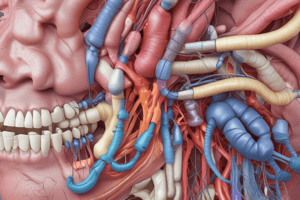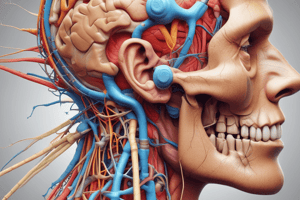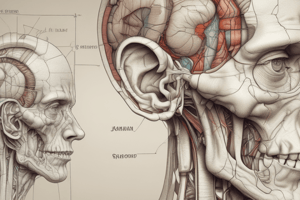Podcast
Questions and Answers
Which cranial nerve exits the skull through the jugular foramen and is responsible for turning the head?
Which cranial nerve exits the skull through the jugular foramen and is responsible for turning the head?
- CNXI: Accessory nerve (correct)
- CNX: Vagus nerve
- CNIII: Oculomotor nerve
- CNVI: Abducens nerve
What forms the medial boundary of the external auditory canal?
What forms the medial boundary of the external auditory canal?
- Auricle
- Earwax
- Tympanic membrane (correct)
- Pinna cartilage
Which cranial nerve is responsible for tongue movement and can indicate atrophy when damaged?
Which cranial nerve is responsible for tongue movement and can indicate atrophy when damaged?
- CNV: Trigeminal nerve
- CNXI: Accessory nerve
- CNXII: Hypoglossal nerve (correct)
- CNVII: Facial nerve
What is the primary blood supply for the external ear?
What is the primary blood supply for the external ear?
Which part of the external auditory canal is made of cartilage?
Which part of the external auditory canal is made of cartilage?
What is the main purpose of lining up the light source with the nasal cavity during examination?
What is the main purpose of lining up the light source with the nasal cavity during examination?
Which of the following is NOT a common pathological finding when examining the nasal cavity?
Which of the following is NOT a common pathological finding when examining the nasal cavity?
How is nasal misting performed?
How is nasal misting performed?
What does the Modified Cottle’s Test aim to assess?
What does the Modified Cottle’s Test aim to assess?
What symptom can posterior cobble-stoning in the oropharynx indicate?
What symptom can posterior cobble-stoning in the oropharynx indicate?
Flashcards are hidden until you start studying
Study Notes
Cranial Nerve & Head Movement
- The cranial nerve XI (Accessory Nerve) exits the skull through the jugular foramen.
- It is responsible for turning the head.
External Auditory Canal Anatomy
- The medial boundary of the external auditory canal is formed by the tympanic membrane.
- The lateral portion of the external auditory canal is cartilaginous.
Cranial Nerve & Tongue Movement
- The cranial nerve XII (Hypoglossal Nerve) is responsible for tongue movement.
- Atrophy of the tongue can be a sign of damage to the Hypoglossal Nerve.
External Ear Blood Supply
- The primary blood supply for the external ear is the posterior auricular artery.
Nasal Examination: Light Source Alignment
- Aligning the light source with the nasal cavity during examination helps illuminate the nasal passages for a clearer view.
Common Nasal Cavity Pathologies
- The presence of polyps is a common pathological finding during nasal cavity examination.
- Nasal septal deviation is another commonly observed pathology.
- Inflammatory changes are frequently encountered in the nasal cavity.
- Foreign bodies can be lodged in the nasal cavity.
Performing Nasal Misting
- Nasal misting is performed by applying a saline solution to the nasal passages using a spray bottle.
Modified Cottle’s Test Assessment
- The Modified Cottle’s Test aims to assess the patency of the nasal airway.
- It is performed by observing the movement of the nasal ala during inspiration and expiration.
Posterior Cobble-stoning in the Oropharynx
- Posterior cobble-stoning in the oropharynx can indicate inflammation or infection.
Studying That Suits You
Use AI to generate personalized quizzes and flashcards to suit your learning preferences.




